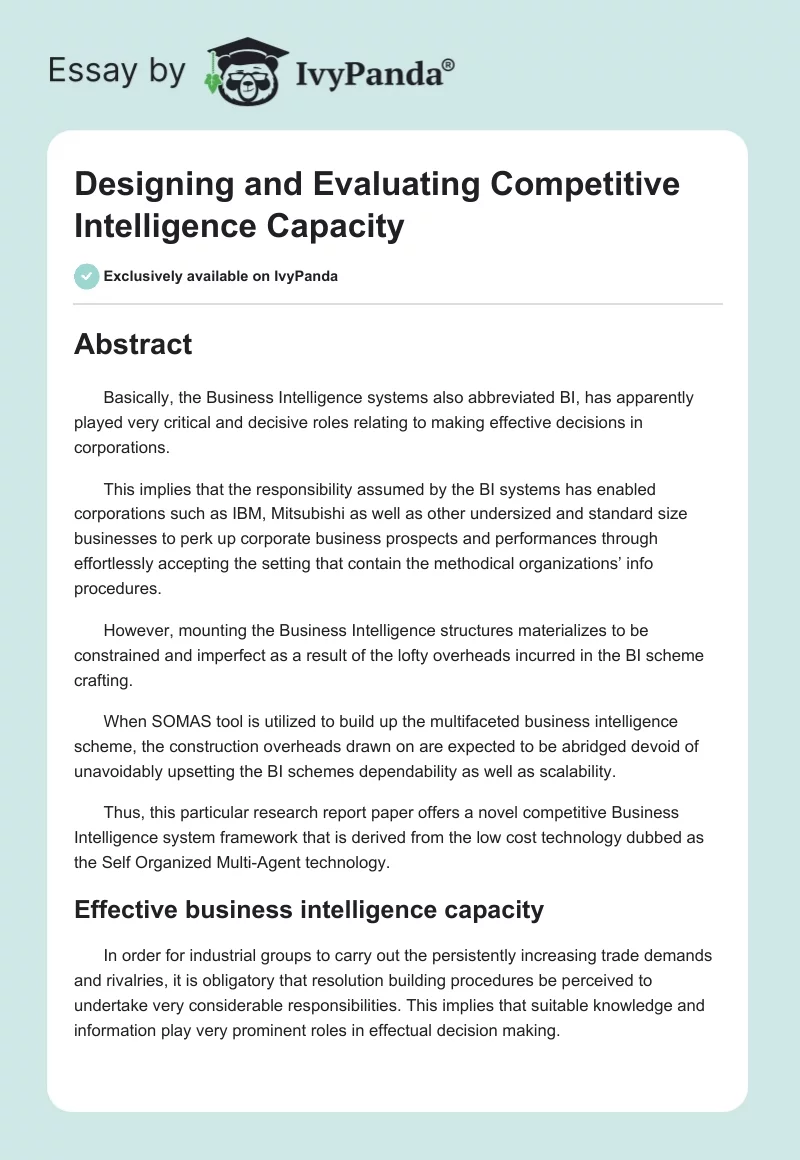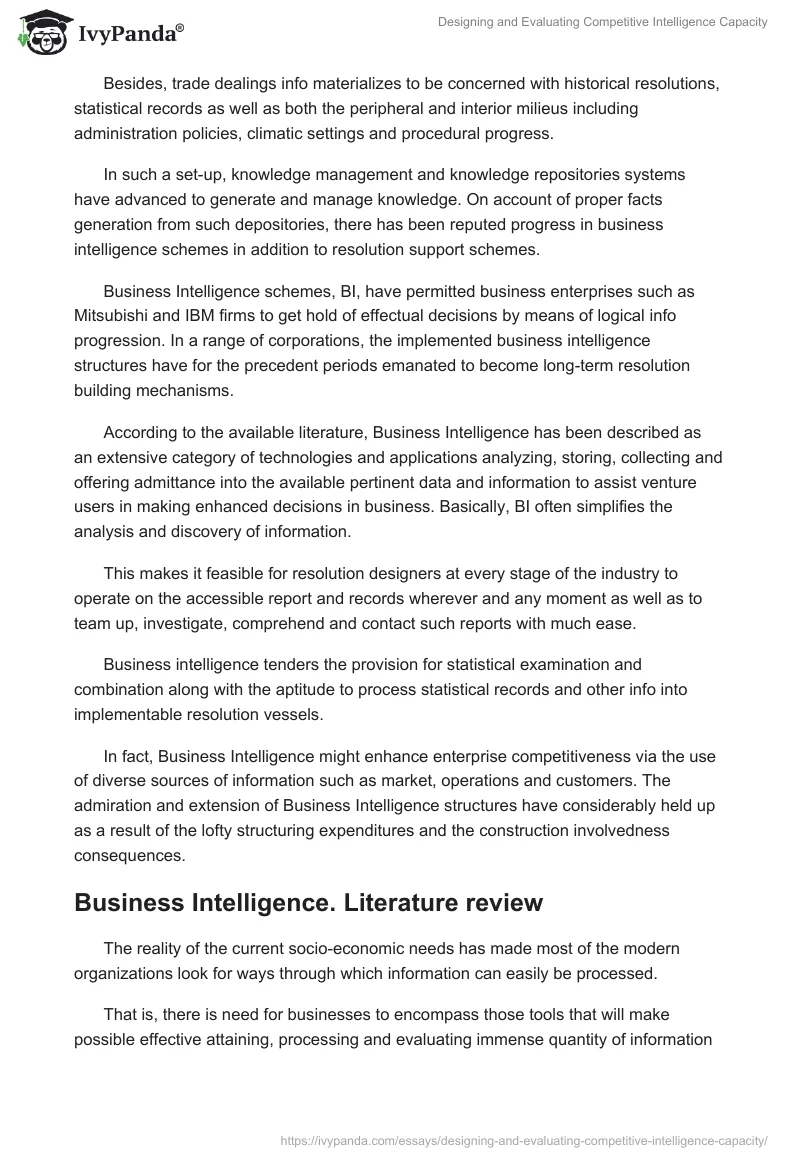Abstract
Basically, the Business Intelligence systems also abbreviated BI, has apparently played very critical and decisive roles relating to making effective decisions in corporations.
This implies that the responsibility assumed by the BI systems has enabled corporations such as IBM, Mitsubishi as well as other undersized and standard size businesses to perk up corporate business prospects and performances through effortlessly accepting the setting that contain the methodical organizations’ info procedures.
However, mounting the Business Intelligence structures materializes to be constrained and imperfect as a result of the lofty overheads incurred in the BI scheme crafting.
When SOMAS tool is utilized to build up the multifaceted business intelligence scheme, the construction overheads drawn on are expected to be abridged devoid of unavoidably upsetting the BI schemes dependability as well as scalability.
Thus, this particular research report paper offers a novel competitive Business Intelligence system framework that is derived from the low cost technology dubbed as the Self Organized Multi-Agent technology.
Effective business intelligence capacity
In order for industrial groups to carry out the persistently increasing trade demands and rivalries, it is obligatory that resolution building procedures be perceived to undertake very considerable responsibilities. This implies that suitable knowledge and information play very prominent roles in effectual decision making.
Besides, trade dealings info materializes to be concerned with historical resolutions, statistical records as well as both the peripheral and interior milieus including administration policies, climatic settings and procedural progress.
In such a set-up, knowledge management and knowledge repositories systems have advanced to generate and manage knowledge. On account of proper facts generation from such depositories, there has been reputed progress in business intelligence schemes in addition to resolution support schemes.
Business Intelligence schemes, BI, have permitted business enterprises such as Mitsubishi and IBM firms to get hold of effectual decisions by means of logical info progression. In a range of corporations, the implemented business intelligence structures have for the precedent periods emanated to become long-term resolution building mechanisms.
According to the available literature, Business Intelligence has been described as an extensive category of technologies and applications analyzing, storing, collecting and offering admittance into the available pertinent data and information to assist venture users in making enhanced decisions in business. Basically, BI often simplifies the analysis and discovery of information.
This makes it feasible for resolution designers at every stage of the industry to operate on the accessible report and records wherever and any moment as well as to team up, investigate, comprehend and contact such reports with much ease.
Business intelligence tenders the provision for statistical examination and combination along with the aptitude to process statistical records and other info into implementable resolution vessels.
In fact, Business Intelligence might enhance enterprise competitiveness via the use of diverse sources of information such as market, operations and customers. The admiration and extension of Business Intelligence structures have considerably held up as a result of the lofty structuring expenditures and the construction involvedness consequences.
Business Intelligence. Literature review
The reality of the current socio-economic needs has made most of the modern organizations look for ways through which information can easily be processed.
That is, there is need for businesses to encompass those tools that will make possible effective attaining, processing and evaluating immense quantity of information that come from diverse and unrelated sources and that would serve as some basis for discovering new knowledge (Celina & Ziemba, 2007).
Revolutions that are taking place in the marketplace have timely administrators of corporations to swiftly respond in an attempt to continue being aggressive. In order to react quickly to the changes that take place in the market place, there is need for organizations to have management information system that will enable efficient analysis of different information (Bigus & Bigus, 2001).
In addition, organizations need efficient systems that can easily recognize the fast changing business dynamics and challenges. Further, efficient systems should enable organizations respond promptly and accurately to the challenges and dynamics of current business environment (Parunak, 1997).
Moreover, organizations need an information system that can enable them anticipate market trends, easily identify new opportunities, enable them transform their strategies and re-channel their resources so as to become highly competitive (Bussler, 2003).
Organizations constantly collect significant volumes of data and even have access to larger volumes of data from outside the business (Di-Marzo, Gleizes & Karageorgos, 2005). Therefore, they must be capable of transforming this raw data into actionable information through consolidation, organizing, capturing, distributing, storing, analyzing and providing quick feedback as well as easy access.
This will make the company have competitive advantage over others (Gleizes, Camp & Glize, 1999). All these functions are the major objective of Business Intelligence (BI) within an organization. In essence, BI helps organizations create knowledge from the processed information.
This information will enable the organizations make better decisions and convert those decisions into meaningful action that will immensely benefit the organization (Wu, Barash & Bartolini, n.d.).
Besides, BI helps organizations deal with critical issues including getting areas with increased growth opportunities, understanding the competitiveness of the organization in the market place, understanding the areas of profits and losses, understanding and recognizing the trends in the customer behavior, determining the organizations key performing indicators as well as altering the business processes in order to increase productivity (Bigus & Bigus, 2001).
Using the BI systems, organizations can easily analyze the historical data that was created by the business or resulting from the external sources such as the demographic data or that relating to the climatic conditions.
In addition, BI would be useful in studying and understanding particular line of business or function. Furthermore, the information analyzed can be used in understand the business trends, weaknesses, strengths as well as understanding the behavior of the competitors and the situation of the market (Ariyachandra & Watson, 2005).
Before the discovery of the BI technologies, businesses relied on the conventional standard methods to convert data into actionable information. Using conventional methods required labor and time. Moreover, the process required a huge amount of resources and in most cases accompanied with immense human error.
In due course, the info structures have progressed to exceedingly smart Business Intelligence schemes from the customary management info schemes.
The information systems that have been there over the years include Management Information System (MIS), Decision Support System (DSS), Enterprise Systems (ES), Enterprise Intelligent Systems (EIS) and the Business Intelligence (BI) Systems which are the most current information systems (Na,Yun & Xin, 2007). See the evolution of the information system below.
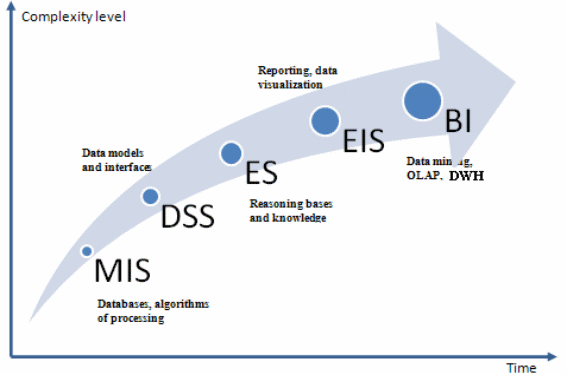
In administration provisions, business intelligence has often been utilized in the description of know-how that corporations like Mitsubishi and IBM exploit to amass statistical info, examine info, stockpile info and supply that info for enhanced resolution making procedures.
In most cases, the information being provided always concern the enterprise. It is asserted that proficient business intelligent schemes proffer the unsurpassed resolutions to the most refined amenities and tasks for successful examination of business statistical info. This is done so as to improve and to support management decisions making process across a wide range of business activities (Bigus & Bigus, 2001).
The BI systems are built upon the integration of Databases, Web Services, Data Mining technologies, Data Warehousing technologies and advanced visualized Interfaces (Ariyachandra & Watson, 2006).
In the execution course, the BI structures ought to be noshed with lofty speed set of connections to convey the statistical info from the disseminated info resource basis to the innermost resources stockrooms or warehouses. In addition the centralized data warehouses should be voluminous enough to store the large data that are being transmitted. These high speed networks and large volume warehouses are always costly (Parunak, 1997).
Business Intelligence (BI) is all about providing information to the organization. One of the most important components of the BI system is the centralized data warehouse. It is the component that stores huge amount of data that the organization needs.
BI infrastructure is not just built for the organizations to get a particular advantage rather as a business necessity (Parunak, 1997). The requirement of the BI is for the organizations to have a structured and organized information environment.
In the structure, the businesses will have different types and organizations of data which can further be organized into a structured environment as an information pyramid (Rodriguez, Hilaire & Koukam, 2003).
Building a BI data infrastructure is costly to most organizations (Di-Marzo, Gleizes, & Karageorgos, 2005). Attributable to the soaring overheads implicated, small as well as medium business ventures generally get troubles in constructing and upholding the business intelligence schemes.
Moreover, the complexities in establishing and maintain the high speed networks as well as the high level storage devices is beyond reach of most small and medium enterprises (Bigus & Bigus, 2001). Though various frameworks as well as architectures have been developed over the years to reduce the cost of BI systems, most of the businesses are still finding it difficult to implement.
A BI system design that is based on the self organized Multi agent technology has been found to reduce cost of establishment and sustainability (Gleizes, Camp & Glize, 1999). This in effect will increase the affordability of the BI to the small and medium enterprises.
BI systems are built in such a way that they work with agents to create an end user results. Agents are considered to be something that can be seen as understanding the immediate environment through sensors and acting on that environment through effectors (Na,Yun & Xin, 2007).
There are three functions that are normally being performed by the intelligent agents that include the awareness of lively and ever changing circumstances in the environment, taking actions to affect these conditions that exist in the environment and have analytic capability to deduce perceptions, draw inferences, solve problems and determine actions (Rodriguez, Hilaire & Koukam, 2003).See figure B below.
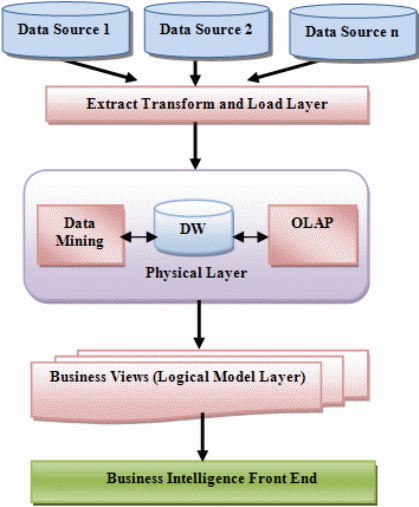
The MAS (Multi-Agent Systems) has been chosen by majority to be the best in developing the most complex systems because of its scalability as well as the reliability with reduced building cost (Armugam & Devadas, 2010). There are a number of agents that make the Multi-agent systems.
These agents have the duty of implementation the tasks assigned. For these agents to complete these tasks there must be communications between themselves. In other words, there must be coordination between the agents in order to complete the assigned task. MAS have the advantage of reducing the developing time as well as the complexities of implementing the software agents (Hayes-Roth, 1995).
Agents that are used in the MAS can be categorized as the static agents or the mobile agents. Static agents normally reside in the original location and the information is exchanged with the outside world through the mechanism of communication and at the same time collaborates with other agents (Lin, Hong & Chen, 1998).
Attributes of the static gents includes autonomy, reaction, interaction and inventiveness. On the other hand, cellular phone mediators terminate the consumer responsibilities not at the initial point, but while stirring from diverse joints that are offered. Mobile agents are characterized by the parallelism, mobility, synchronism and resources optimization (Na,Yun & Xin, 2007).
Integrating multi-agent technology with self organization will handle agent organization effectively (White, 2006,). In a self organized multi-agent system the driving forces also called the agents might be well thought-out into arrangements for constructive appliances devoid of commanding peripheral innermost runs.
These independent units are supposed to cognizant of the immediate surrounding environment and communicate accurately with the environment then relay the message (Gleizes, Camp & Glize, 1999). In other words, the units are supposed to be self-regulating and in so doing make decisions that will be useful in implementing the given assignment
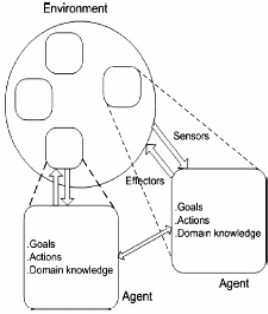
BI systems have been applied in various core functions of an organization. These core functions include operations, finance, customer services, human resources management and marketing (Russell & Norvig, 2005). In the operations, the BI systems are used by the organization management to meet their operational performance measurements.
For instance, in Retail Company each manager can receive a digital dashboard containing summaries of key performance indicators in their respective areas of responsibility (Gleizes, Camp & Glize, 1999). These areas may include the store, merchandise department, loss prevention, risk or cash flows.
In circumstances where the performances have fallen below the preset requirement, the BI systems can be useful in sending signals to the managers identifying the potential problems.
This will enable the mangers to monitor the performance matrices, analyze the information, make the proactive decisions and act on those decisions (Nicholls, 2006). With the BI systems managers can easily visualize the impact of the changes that has been made as a result of changing the performance indicators on the dashboard (Rodriguez, Hilaire & Koukam, 2003).
In finance core competence, BI systems provide an immediate access to financial budgeting and forecasting data (Na,Yun & Xin, 2007). This will enable businesses make accurate decisions based on the current financial information.
The current data may be needed by management to make decisions including personalized views of revenue information by customer, product, merchandize, region and store as well as time period (Rodriguez, Hilaire & Koukam, 2003). BI systems also enable organization managers develop a trend in revenues for speedy and accurate forecasting.
Moreover, financial information will enable managers to compare and contrast the organization revenues with goals as well as identifying areas in which the organization is performing better or worse. In such a situation the organization is armed with accurate information that will enable them act promptly and accurately (Ariyachandra & Watson, 2006).
In customer services, BI enables the organizations to assess various market segments. The BI systems also help companies identify new customers, as well as new potential business areas as well as retaining the existing business (Power, 2001).
For instance, BI makes it easy to correlate the sales information with that of the customers. Those organizations that focus on customer’s relations and services have typically realized the significant competitive advantage (Klein & Tichy, n.d).
Further, BI systems have been used by the organizations to support their human resources activities including employee retention, recruitment and career development. Organizations can align the staffing needs with the strategic goals by mapping those goals with the skills needed to achieve them (Gleizes, Camp & Glize, 1999).
The organizations then can go further to identify the recruitment methods and practices that will bring in high quality and skilled individuals on board. In addition, the organization can further identify new potential candidates for management. BI is also important in critical areas such as the compensation planning, employee benefit planning, productivity planning and skills rating (Bigus & Bigus, 2001).
Marketing is the core competency within an organization where BI is highly needed. Within most organizations that have adopted BI systems, marketing is the area that have greatly benefited from BI systems (Rodriguez, Hilaire & Koukam, 2003).
In marketing, BI is vital in identifying various business trends, revenue analysis on daily basis, high performance identification, quantifying the impact of price changes as well as identifying the opportunities for growth (Douglas, 1993).
For instance a tracking company can use the BI to identify and analyze the fuel rate increase in order to determine things such as the impact on profitability and revenue, identifying the low/heavy impact segments, obtaining the optimizing tracking routes as well as identifying the multi-modal routing opportunities.
The selected technology
To minimize the high construction costs and the effect of building complexities associated with the BI systems, technology dubbed as Self Organized Multi-Agent System (SOMAS) is seen to be very supportive.
The technology supports robustness and high level scalability as it creates complex systems at the least cost possible. To build a multifaceted system such as Business Intelligence system anchored on SOMAS technology might definitely guarantee a minimal cost outlay resolution.
Thus, this research report paper tends to introduce a very novel approach through the use of SOMAS technology in designing a minimal cost BI system. The organization of the paper is as follows. The second section offers a brief literature review as regards to a variety of information systems.
The third section presents novel SOMAS framework design, Self Organized Multi-Agent System that can be used to build Business Intelligence at minimum cost. That is, all the inputs, outputs and BI capabilities will be identified and evaluated in the third section.
Any eminent problems in the BI system will be identified and analyzed in the fourth section (Gleizes, Camp & Glize, 1999). The conclusions and recommendations for improvement on the BI system will consequently follow.
A framework design for Business Intelligence System (BI) based on Self-Organized Multi-Agent System Technology (SOMAS Technology)
When companies such as Mitsubishi and IBM Corporation use Self Organized Multi-Agent technology to implement the Business Intelligent Systems, they are likely to minimize the associated costs.
This is made possible as a result of various tasks execution by agents namely data mining, analyzing, querying, metadata extraction and data cleansing. In fact, whilst various Business Intelligence tasks are being executed using such agents, data storage and transfer are likely to be reduced hence minimizing the allied costs (Douglas, 1993).
The diagram below shows a framework design of the Business Intelligence system anchored on the technology called Self Organized Multi-Agent system.
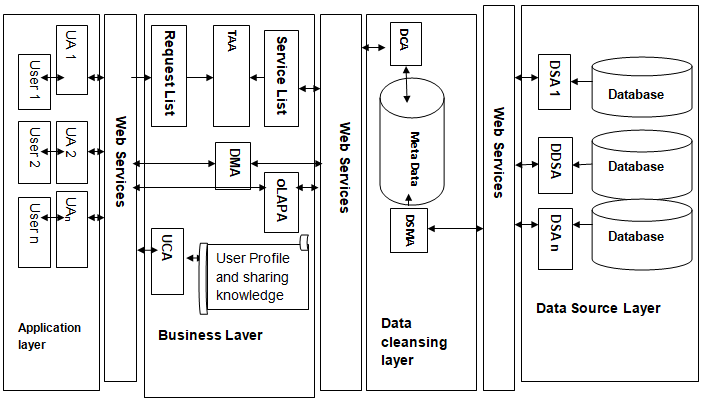
BI capabilities inputs and outputs as well as an evaluation of BI capabilities performance
The present BI system framework built on SOMAS technology comprise of four notable layers. However, every layer has special dedication of executing a solitary key task of the Business Intelligence system.
In the BI system framework, it is apparent that all upper layers freely network with the all the layers via the well designed web services. The four distinctive layers of the self organized multi-agent technology support business intelligence framework include:
- The data source layer
- The data cleansing layer
- The business layer and,
- The application layer
From the above framework, the Application Layer plays a critical role of presenting the users’ interfaces to each of the users through setting up decisive connections for providing several services. The services include data mining, analysis and querying to the end users in a visualized and interactive mode.
The Data Source Layer found in the BI system framework plays the central functionalities of offering the basic data services to the Data cleansing Layer from assorted data resources. This layer similarly establishes and maintains the restricted metadata.
The Business Layer offers central functionalities to the layer dubbed as the Application Layer (Rodriguez, Hilaire & Koukam, 2003). Within the Data Cleansing Stratum or layer, the available pertinent data undergoes through the process of refinement in order to maintain the integrity and accuracy of data. The process materializes to assist the corporations in improving the correctness of information.
On the other hand, the SOMAS technology based BI system framework above comprises of manifold agents. The core agents in the framework which are bound to play critical roles when the BI system is being implemented are:
- The data source agent (DSA).
- The data cleansing agent (DCA).
- The data mining agent (DMA).
- The Tasks allocation agent (TAA).
- The User control agent (UCA).
- The user agent (UA).
- The data source management agent (DSMA).
- The online or web analytical processing agents (OLAPA).
Within the application layer, there is the existence of the User Agent. In fact, any new user agent is created by the User Control Agent anytime the users of the system log into the SOMAS technology based Business Intelligence system. Such new user agents are then destroyed each time the system users log out.
This systems User Agent functionalities to the corporations such as Mitsubishi and IBM Companies is to offer Business Intelligence services to all users as well as sending each request that has been made to the list of requests (Ariyachandra & Watson, 2006).
Consequently, the ensuing effects from diverse agents are obtainable to the users of the system. This is done within the preferences of end users of the system normally in cooperative and envisaged approach.
The User Control Agent (UCA) on the other hand is present within system’s Business Stratum or layer. Basically, the User Control Agent plays a critical role pertaining to; the sharing of knowledge, maintenance of the users’ profiles and controlling the system’s user agent alongside the provision of the joint results querying by intelligently accomplishing some tasks in support of the SOMAS technology based Business Intelligent system’s users as indicated by the history of the users.
Conversely, it is within the System’s Business Layer where Task Allocate agent is situated. Such an agent plays the core duty of assigning numerous contractual obligations and tasks founded on the services and requests made. Further, the Task Allocate Agent manages both the service lists as well as the requests lists.
Practically, the Task Allocate Agents carry out the system users’ requests through handing most of such requests over to the analogous or subsequent system services.
The online or web analytical processing agents also called OLAPA agent is similarly situated within the Business Stratum or Layer. The OLAPA instrument presents the investigative online handling services comprising of examination of the data systems. It also permits various reviewing as well as screening of the organization data.
However these are done online curtail delays that may exists. Besides, the OLAPA agent in the SOMAS technology based Business Intelligent system offers the critical function called multidimensional analysis of the system’s data (Gleizes, Camp & Glize, 1999).
In the Systems Data Cleansing Layer, there is equally the presence and existence of the Data Cleansing Agent. While executing its tasks to the system’s users, the DCA agent applies services relating to the cleansing of the system’s data to any data acquired from the system’s numerous data resources.
In most cases, the DCA (Data Cleansing Agent) plays a significant role pertaining to the detection and removal of the data inconsistencies and errors and improving on the system’s data quality for purposes of processing (Rodriguez, Hilaire & Koukam, 2003).
In the system’s Business Layer, there is the Data Mining Agent (DMA). Within the SOMAS technology based Business Intelligent system, the DMA agent provisionary offers the system’s data mining services founded on different data mining algorithms and techniques. The DMA agent is always very intuitive.
Hence it allows for improved insight that goes above the online or web analytical processing agents, by analyzing the systems large databases. This DMA agent functionality helps the system in solving various business decisions making problematic upshots.
The Data Mining Agent furthermore predicts the system’s prospective behaviours as well as trends, thus enabling corporations to craft knowledge driven and proactive business decisions. More often, the Data Mining Agents in the system may respond to the business tailored problems and queries which were deemed to be customarily time involving being resolved (Bigus & Bigus, 2001).
Within the system’s Data Cleansing Layer, there is similarly the existence of the Data Source Management Agents (DSMA). In essence, the DSMA agent plays a decisive role relating to the monitoring of different sources of the system’s data as well as the localized metadata found in most springs of data.
The Data Source Management Agents also assists in managing the system users’ universal metadata bases. The DSMA agent always obtains scores of the system’s data inquiries particularly those that ensue from the SOMAS technology based Business Intelligent system upper layer (Klein & Tichy, n.d).
The received inquiries are thereafter propelled to the respective data resource agents who assimilate the outcomes which are then taken back by the system’s agent of the data source.
Finally, from the SOMAS technology based Business Intelligent system above, it emanates that within the Data Source Stratum, there is the existence of the Data Source Agent (DSA). The DSA attempts to manage all the heterogeneous and assorted data sources for purposes of providing the upper layer with central data services.
From the system’s framework diagram, the central data services incorporate data queries receipt, data mining and extraction for the accomplishment of the respective tasks, the provision of various data sets for analytical and querying purposes along with the management of the localized metadata (Na,Yun & Xin, 2007). These are then sent to the system’s upper layer to maintain the universal metadata.
Problems associated with the SOMAS technology based Business Intelligent system
The intelligent agents and the Business Intelligent have come out to be variant areas of research. Recently, research attempts to link the two areas.
Whereas Business Intelligent has been used successfully to provide info and data from various structured sources, the BI system has frequently failed at both the Mitsubishi and IBM corporations to provide data and info from the disseminated sources where such data and info are kept in the unstructured files and document.
In addition to this, there exist various other unresolved problems within the existing frameworks of the Business Intelligent system. It is recommended that to solve most of the looming unresolved problems, a corporation such as IBM Corp could integrate the present intelligent agents within the Business Intelligent system.
Conclusion and Recommendations
The Business Intelligence field has been evolving since time in memorial. This implies that, its business use significance has been very well established. While some new BI issues have surfaced requiring research attention, other BI system issues have progressively matured with time.
It is however worth noting that Business Intelligence systems dynamically try to support the activities conducted by corporations’ managers in an attempt to gain some insights into the corporations’ processes and outcomes. This requires that use of technologies and tools like advanced reporting, data mining, ETL processes and data warehousing.
Such technologies and tools have greatly handled structured info and data in various organized environments. Nevertheless, they have limited capacities to handle BI system’s data and info which are unorganized and those that do not essentially derive from well classified sources.
The Business Intelligent system framework above that has been derived from Self Organized Multi-Agent technology has the capacity of improving the reliability and scalability of the BI system.
This is because it can be put up at minimal building cost which in turn helps in the improvement of the Business Intelligence System’s affordability by both the medium and small scale business enterprises as well as large corporations such as Mitsubishi and IBM Company.
However, the failure of the BI system to provide data and info from the unstructured distributed documented sources persists to be a challenging problem to most corporations. Integrating the Business Intelligent system’s intelligent agents is one sure way to deal with the encountered problem.
References
Ariyachandra, T & Watson, H 2005, “Key factor in selecting a data warehouse architecture”, Business Intelligence Journal, vol.10 no.2, pp.26-59.
Ariyachandra, T & Watson, HJ 2006, “Which data warehouse architecture is most successful”, Business Intelligence Journal, vol.11 no.1, pp.71-92.
Armugam, B & Devadas, J 2010, “Object oriented intelligent multi-agent system data cleaning architecture to clean preference based text data”, International Journal of Computer Applications, vol.9 no.8, pp.57-65.
Bigus, JP & Bigus, J. 2001, Constructing intelligent agents using java, John Wiley & Sons, New York.
Bussler, B, 2003, B2B integration: Concept and architecture, Springer, Berlin Heidelberg.
Celina, MO & Ziemba, E. 2007, “Approach to building and implementing business intelligence systems”, Interdisciplinary Journal of Information, Knowledge, and Management, vol.2 no.5, pp.24-36.
Di-Marzo, SG, Gleizes, MP & Karageorgos, A. 2005,”Self-organisation and emergence in mass: an overview”, Informatica, this issue, vol.3 no.1, pp.15-20.
Douglas, H. 1993, “Business intelligence: competing against time”, Twelfth Annual Office Information Systems Conference, vol.10 no.2, pp.27-33.
Gleizes, MP, Camp, V & Glize, P. 1999, “A theory of emergent computation based on cooperative self-organisation for adaptive artificial systems”, 4th European Congress of Systems Science, vol.1 no.3, pp.90-99.
Hayes-Roth, B. 1995, “An architecture for adaptive intelligent systems”, Artificial Intelligence: Special Issue on Agents and Interactivity, vol.72 no.1, pp.66-71.
Klein, F & Tichy, M. n.d, Building reliable systems based on self organizing multi agent systems. Web.
Lin, WJ, Hong, JL & Chen, XH. 1998, “Expert systems and multi- agent cooperative systems”, Computer Science, vol.25 no.1, pp.27-58.
Na, X, Yun, ZW & Xin, P. 2007, “Research on business intelligence model based on agent”, Computer Applications and Software, vol.24 no.3, pp.110-131.
Nicholls, C. 2006, “BI 2.0: how real time business intelligence is irrevocably changing the way that we do business”, In Search Insight.
Parunak, VH. 1997, “Go to the ant: engineering principles from natural multi-agent systems”, Annals of Operations Research, vol.75 no.1, pp.69-101.
Power, D. 2001, “Supporting decision-makers: an expanded framework”, Proceedings of the Informing Science and IT Education Conference. Web.
Rodriguez, S, Hilaire, V & Koukam, A. 2003, “Towards a methodological framework for holonic multi-agent systems”, Proceedings of the Fourth Workshop on Engineering Societies in the Agents World (ESAW’03), vol.10 no.4, pp.31-45.
Russell, SJ & Norvig, P. 2005, Artificial intelligence a modern approach, Prentice Hall International, Englewood Cliffs, NJ.
White, C. 2006, Business intelligence network: The vision for BI and beyond.
Wu, L, Barash, G & Bartolini, C. n.d, Service oriented architecture for business intelligence. Web.

